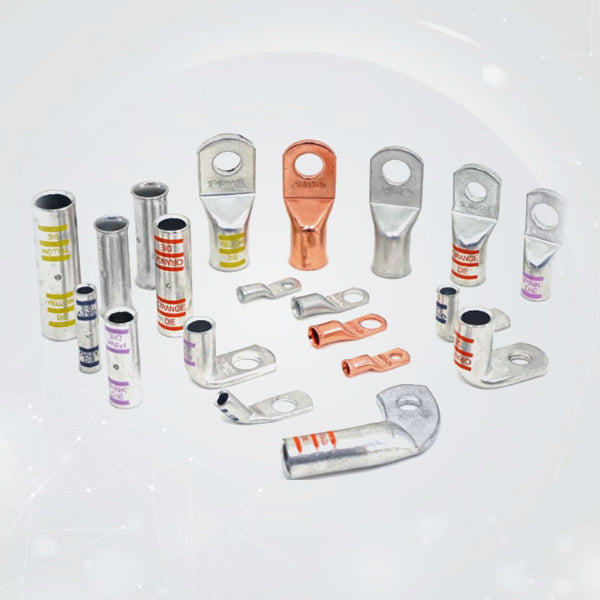
Improving Electrical Conductivity with Copper Wire Lugs
In the intricate world of electrical systems, conductivity reigns supreme. The efficiency of any electrical circuit is fundamentally linked to the ability of its components to conduct electricity with minimal resistance. This is where copper lugs, and more specifically, copper wire lugs, emerge as indispensable components. Renowned for their superior conductivity, copper lugs serve as the backbone of a vast array of electrical applications, spanning from simple residential wiring to complex industrial setups. This article delves into the reasons why copper wire lugs are so crucial for enhancing electrical conductivity and ensuring the seamless flow of power.
The Unmatched Conductivity of Copper
Copper's position as one of the most electrically conductive metals, second only to silver, is a cornerstone of electrical engineering. This inherent property makes copper lugs an ideal choice for electrical connections. High conductivity directly translates to lower resistance, which means less energy is dissipated in the form of heat as electricity traverses the connection. This efficiency is not merely a matter of conserving energy; it's a critical factor in preventing overheating and ensuring that electrical systems operate optimally and safely. In high-current applications, where substantial amounts of electricity flow through the connections, the use of copper lugs becomes even more vital. Their ability to minimize resistance ensures that the electrical energy reaches its destination with minimal loss, preventing voltage drops and maintaining system stability.
The Role of Copper Wire Lugs
Copper wire lugs are meticulously designed to terminate copper wires, providing a secure and efficient connection point. These lugs act as the interface between the wire and various electrical components, such as busbars, circuit breakers, and equipment terminals. The design of copper terminal lugs is optimized to maximize the contact area between the wire and the connection point, further minimizing resistance and ensuring a smooth flow of electricity. This is achieved through a combination of factors, including the precise dimensions of the lug barrel, the quality of the copper material, and the method used to attach the lug to the wire. Whether it's a small gauge wire in a residential circuit or a large gauge cable in industrial machinery, there's a copper lug designed to provide a reliable and efficient connection.
Advantages of Using Copper Lugs
- Superior Conductivity: The primary advantage of copper lugs lies in their exceptional conductivity. This is paramount in high-current applications where minimizing energy loss is not just desirable but essential for preventing overheating and ensuring system stability.
- Thermal Efficiency: The low resistance of copper lugs not only enhances conductivity but also reduces heat generation. This is vital for preventing thermal runaway, a dangerous condition that can lead to electrical fires and equipment damage. By keeping the connections cool, copper lugs contribute to the overall safety and reliability of electrical systems.
- Durability and Reliability: Copper is an inherently durable material that can withstand a wide range of environmental conditions. Copper wire lugs provide reliable connections that maintain their integrity over time, reducing the need for frequent maintenance and replacements. This is particularly important in industrial settings where downtime can be costly and disruptive.
- Versatility: Copper battery cable lugs are available in a wide variety of sizes, shapes, and designs, making them adaptable to a broad spectrum of applications. Whether it's for connecting small gauge wires in delicate electronic circuits or large gauge cables in heavy-duty machinery, there's a copper lug engineered to meet the specific requirements of the job.
Installation Best Practices for Copper Wire Lugs
To fully leverage the benefits of copper lugs, proper installation is essential. Adhering to best practices ensures that the connections are not only electrically sound but also mechanically robust. Here are some key guidelines:
- Cable Preparation: The first step in installing copper wire lugs is to prepare the cable correctly. This involves stripping the insulation from the end of the cable to the appropriate length, ensuring that the copper strands are clean and undamaged. The typical strip length is between 5/8" and 3/4", but it can vary depending on the cable gauge and the specific lug being used. It's crucial to use a wire stripper tool to avoid nicking or cutting any of the strands, as this can weaken the wire and increase resistance.
- Cleanliness: Maintaining cleanliness is paramount throughout the installation process. Ensure that both the cable and the copper lug are clean and free from any contaminants, such as dirt, grease, or corrosion. These substances can impede conductivity and compromise the integrity of the connection. If necessary, use a wire brush or a cleaning solution to remove any debris before proceeding.
- Proper Crimping: Crimping is the most common method for attaching copper wire lugs to cables. It involves using a specialized tool to compress the lug barrel tightly around the wire, creating a gas-tight seal that maximizes contact area and minimizes resistance. It's essential to use a crimping tool that is appropriately sized for both the copper wire lug and the cable, and to apply firm, even pressure to ensure a secure and effective crimp.
- Secure Fastening: Once the lug is crimped to the cable, it needs to be securely fastened to the terminal or connection point. This usually involves using bolts, nuts, and washers. It's crucial to use the correct hardware and to tighten it to the manufacturer's recommended torque settings. Over-tightening can damage the lug or the terminal, while under-tightening can lead to a loose connection and increased resistance.
- Inspection and Maintenance: After installation, it's essential to thoroughly inspect the connection to ensure that it's properly made. Check for any signs of damage, loose connections, or corrosion. Regular maintenance, including periodic cleaning and tightening, can help maintain optimal performance and extend the lifespan of the connection. A maintenance interval of every 6–12 months is generally recommended, but it may need to be more frequent in harsh or demanding environments.
Technical Details Recap
- Material: High-purity (99.9%) copper
- Recommended Strip Length: 5/8" to 3/4" (varies by cable gauge)
- Maintenance Interval: Inspect every 6–12 months
Conclusion
In conclusion, copper lugs and copper cable lugs are indispensable components for ensuring efficient electrical conductivity in a wide range of applications. Their superior conductivity, thermal efficiency, durability, and versatility make them the preferred choice for electrical connections. By adhering to best practices for installation and maintenance, you can maximize the performance and longevity of your electrical systems, ensuring a safe and reliable flow of power.





